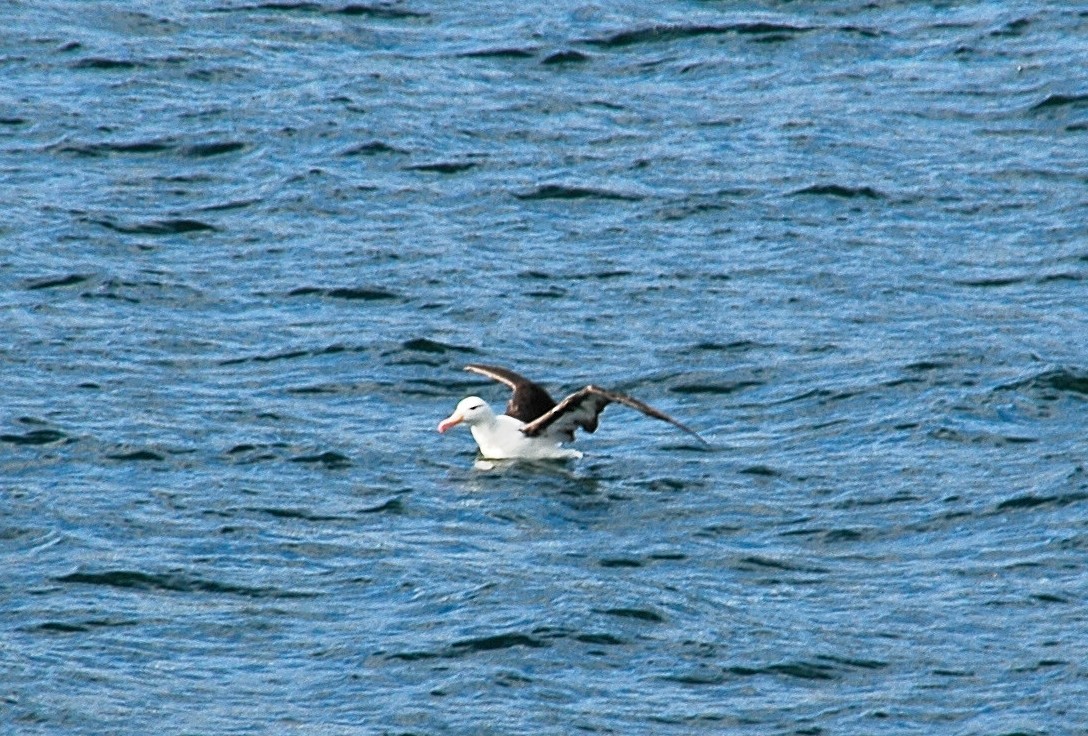Black-browed Albatross
A species of Mollymawks Scientific name : Thalassarche melanophris Genus : Mollymawks
Black-browed Albatross, A species of Mollymawks
Botanical name: Thalassarche melanophris
Genus: Mollymawks
Content
Description People often ask General Info
 Photo By Mirko Thiessen , used under CC-BY-SA-2.5 /Cropped and compressed from original
Photo By Mirko Thiessen , used under CC-BY-SA-2.5 /Cropped and compressed from original Description
The black-browed albatross is a medium-sized albatross, at 80 to 95 cm (31–37 in) long with a 200 to 240 cm (79–94 in) wingspan and an average weight of 2.9 to 4.7 kg (6.4–10.4 lb). It can have a natural lifespan of over 70 years. It has a dark grey saddle and upperwings that contrast with the white rump, and underparts. The underwing is predominantly white with broad, irregular, black margins. It has a dark eyebrow and a yellow-orange bill with a darker reddish-orange tip. Juveniles have dark horn-colored bills with dark tips, and a grey head and collar. They also have dark underwings. The features that distinguish it from other mollymawks (except the closely related Campbell albatross) are the dark eyestripe which gives it its name, a broad black edging to the white underside of its wings, white head and orange bill, tipped darker orange. The Campbell albatross is very similar but with a pale eye. Immature birds are similar to grey-headed albatrosses but the latter have wholly dark bills and more complete dark head markings. 
Size
81-94 cm (32-37 in)
Life Expectancy
60 years
Nest Placement
Cliff
Feeding Habits
Black-browed Albatross's diet includes fish, squid, crustaceans, and carrion. This bird scavenges fishery discards and sometimes kleptoparasitizes, swiping meals from others. Such dietary adaptations highlight its opportunistic feeding habits.
Habitat
The black-browed Albatross predominantly resides in marine environments, often venturing across extensive oceanic areas, thousands of kilometers from land, though it is also prevalent in coastal waters and more enclosed sea regions. It is known for its pelagic nature, frequenting shelf and shelf-break zones. During breeding, the black-browed Albatross favors remote oceanic islands characterized by steep slopes with tussock grass and, occasionally, muddy drainage lines or cliff terraces for nesting. As the most northerly migrating albatross, it occasionally reaches into the North Atlantic.
Dite type
Piscivorous
People often ask
General Info
Feeding Habits
Bird food type
Behavior
Colonies are very noisy as they bray to mark their territory, and also cackle harshly. They use their fanned tail in courting displays. 
Species Status
Until 2013, the IUCN classified this species as endangered due to a drastic reduction in population. Bird Island near South Georgia Island had a 4% per year loss of nesting pairs, and the Kerguelen Island population had a 17% reduction from 1979 to 1995. Diego Ramírez decreased in the 1980s but has rebounded recently, and the Falklands had a surge in the 1980s probably due to abundant fish waste from trawlers; however, recent censuses have shown drastic reduction in the majority of the nesting sites there. There has been a 67% decline in the population over 64 years. Increased longline fishing in the southern oceans, especially around the Patagonian Shelf and around South Georgia has been attributed as a major cause of the decline of this bird, The black-browed albatross has been found to be the most common bird killed by fisheries. Trawl fishing, especially around the Patagonian Shelf and near South Africa, is also a large cause of deaths. Conservation efforts underway start with this species being placed on Convention on Migratory Species Appendix II, and Agreement on the Conservation of Albatrosses and Petrels Annex 1. It is being monitored on half of the islands, and most of the breeding sites are reserves. Heard Island, McDonald Island, Macquarie Island, and the New Zealand islands are World Heritage Sites. An initial Chilean census has also been completed. 
Scientific Classification
Phylum
Chordates Class
Birds Order
Albatrosses and Petrels Family
Albatrosses Genus
Mollymawks Species
Black-browed Albatross